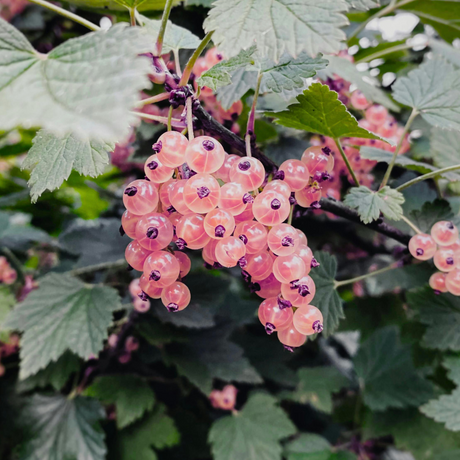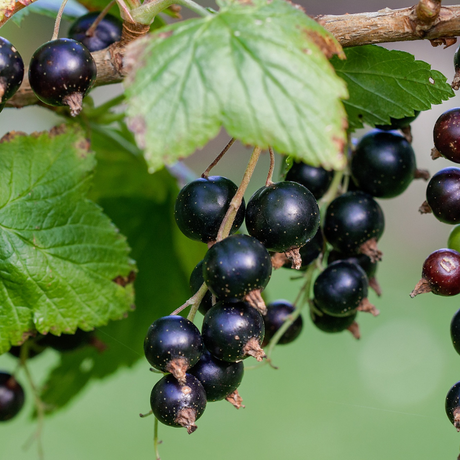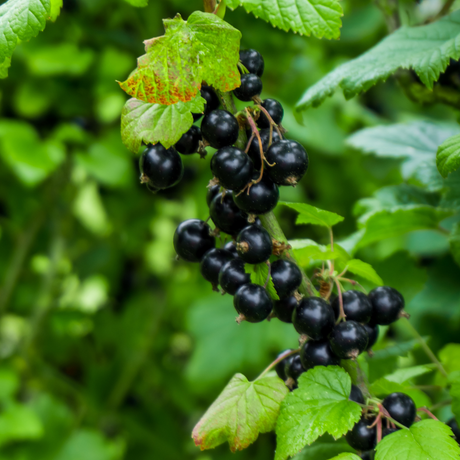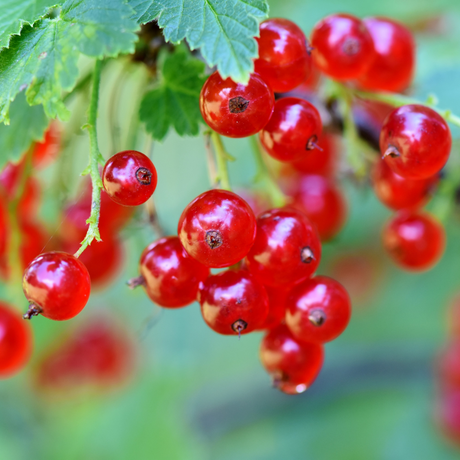Redcurrant 'Jonkheer van Tets' BIO
Regular price €10,86Unit priceUnavailable- Regular price €10,86Unit priceUnavailable
Redcurrant 'Jonkheer van Tets' BIO
Regular price €7,88Unit priceUnavailableBlackcurrant / cassis berry 'Titania' BIO
Regular price €10,86Unit priceUnavailableRedcurrant 'Jonkheer van Tets' BIO
Regular price €7,88Unit priceUnavailableBlackcurrant / cassis berry 'Titania' BIO
Regular price €7,88Unit priceUnavailableRedcurrant 'Jonkheer van Tets' BIO
Regular price €7,88Unit priceUnavailable
Kleinfruit in beeld
Ruud laat zien hoe hij diverse bessen en druiven in zijn tuin kweekt. In de video geeft hij ook tips over het combineren van aalbessen met andere planten in de tuin.
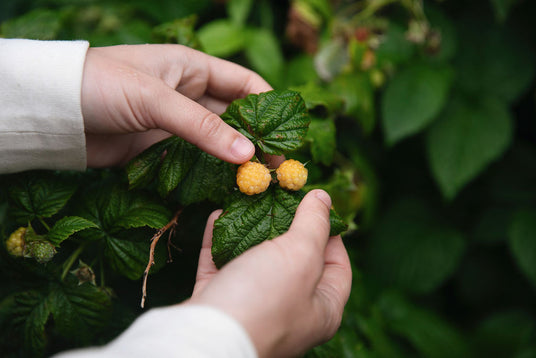
Lees ook onze kleinfruit kweekgids
Dit vind je misschien ook leuk
View allBiologische aalbessenplanten: fruitstruiken waar je blij van wordt
Op zoek naar een makkelijke, lekkere én mooie fruitstruik voor je tuin of balkon? Dan zit je met aalbessen helemaal goed. Deze vruchtbare planten, ook wel bekend als trosbessen, rode bessen, witte bessen, roze bessen of cassisbessen, zijn er in rode, witte, roze en zwarte varianten. De aalbes is oorspronkelijk afkomstig uit Centraal- en Oost-Europa en lid van de kruisbessenfamilie. Ze geven jaar na jaar een royale oogst en kunnen jaarlijks geoogst worden. Bij Plukkers.com vind je alleen biologische aalbessenplanten, speciaal geselecteerd op smaak, gezondheid en groeikracht. Of je nu een beginnende plukker bent of al jarenlang je eigen jam maakt: met deze planten pluk je het beste uit je tuin.
Waarom biologische aalbessenplanten?
Je kiest niet zomaar voor biologisch. Je kiest voor planten die zonder kunstmatige poespas zijn grootgebracht. Ze groeien rustig op en ontwikkelen daardoor een sterke weerstand en rijke smaak. Aalbessen zijn bovendien:
- Boordevol vitamine C, vezels en antioxidanten, goed voor je lijf en lekker fris.
- Productief en betrouwbaar, je plukt volop bessen in juni en juli.
- Geschikt voor elke tuin, of zelfs voor in een pot op je balkon.
- Leuk voor kinderen, plukken, proeven en zelf een siroopje maken.
Welke aalbes past bij jou?
Iedere kleur, zoals rode bes, witte bes en zwarte bes, heeft z'n eigen smaak, toepassing en charme. Al deze verschillende rassen leveren smakelijke vruchten op. Hieronder vind je onze biologische toppers:
Rode aalbes: fris en favoriet
Jonkheer van Tets BIO - deze rode trosbes is een klassieker: friszuur van smaak, stevig van structuur en perfect voor confituur of siroop. De bessen groeien in lange trossen, wat het oogsten vergemakkelijkt. Pluk vroeg en rijk.
Tip: voor de beste oogst aalbessen pluk je de trossen voorzichtig wanneer ze volledig rijp zijn, zodat de bessen niet beschadigen. Een robuuste alleskunner.
Witte aalbes: zacht en verfijnd
Werdavia BIO - een mildzoete bes met een zachte bite. De witte aalbes is een milde vrucht die bekend staat om zijn subtiele smaak. De transparant witte kleur geeft je tuin én je bord iets bijzonders. Ideaal voor frisse desserts.
Roze aalbes: een tikje anders
Gloire des Sablons BIO - zachtzoete, lichtroze bessen die het goed doen bij kinderen én volwassenen. Uniek in kleur, subtiel in smaak. Echt een verrassende aanwinst.
Zwarte aalbes: krachtpatser met karakter
Titania BIO , dit is de cassisbes, ook wel bekend als de zwarte bes, zoals je ‘m hoopt te proeven: vol aroma, donker van kleur en rijk aan antioxidanten. De zwarte bes wordt veel gebruikt voor siroop, jam of gewoon puur natuur.
Zo plant en verzorg je jouw aalbessen
Je hoeft geen groene vingers te hebben om succes te boeken met aalbessen. Met een beetje aandacht groeien ze uit tot sterke, gezonde struiken die een hoogte kunnen bereiken van 1,5 tot 2 meter.
Planttijd: aalbessen kunnen geplant worden vanaf september tot in maart, afhankelijk van het type plant (blote wortel liever voor de winter, voor planten in pot maakt het niet echt uit). Zet de kluit of blote wortel voor het planten eerst in een emmer water.
Standplaats: kies een zonnige standplaats of lichte halfschaduw; een zonnige standplaats is ideaal voor een rijke oogst. Aalbessen hebben een lichte voorkeur voor zanderige grond, maar groeien ook goed op kleigrond mits deze goed is bewerkt. Zorg dat de bodem goed doorlatend is; meng zanderige grond met compost voor optimale groei. Combineer aalbessen gerust met andere planten in de tuin, maar geef ze voldoende ruimte.
Plantafstand: 1 tot 1,5 meter tussen de struiken. Deze afstand zorgt ervoor dat de planten voldoende ruimte hebben om te groeien en gezond te blijven.
Water: geef regelmatig water, vooral in het eerste jaar.
Bemesting: geef in het voorjaar een organische meststof voor kleinfruit om de groei en vruchtvorming te stimuleren.
Snoei: snoei in de winter oude takken tot op het meerjarig hout terug. Let bij het snoeien op buiten gerichte knoppen en knip ook kruisende takken weg voor een luchtige struik. Verwijder niet te veel blad, zodat de plant voldoende fotosynthese kan uitvoeren. Aalbessen ondersteunen helpt om de struik structuur te geven en de groei te begeleiden. Gebruik onze krachtige scherpe snoeischaar.
Stekken: aalbessen zijn eenvoudig te vermeerderen door stekken; snijd in de herfst of het vroege voorjaar een gezonde tak en zet deze in vochtige grond.
Bloei en vruchten: de bloemen van de aalbes zijn belangrijk voor de bestuiving door bijen en andere insecten. Na de bloei ontwikkelen zich de vruchten. Ondanks het feit dat aalbessenplanten zelf bestuivend zijn, plantje best verschillende rassen die elkaar bestuiven voor een betere opbrengst.
Oogst en opbrengst: gemiddeld kun je per struik enkele kilo’s bessen oogsten. Bescherm de struik kun je eenvoudig met netten tegen vogels om de oogst veilig te stellen.
Tip: bescherm de oogst tegen vogels met netten of andere afschrikmiddelen.
Plagen en ziekten bij aalbessen
Je hebt je aalbessenstruiken met liefde geplant en verzorgd, maar zelfs de sterkste kunnen soms te maken krijgen met vervelende plagen of ziekten. Geen paniek! Met de juiste zorg en een beetje oplettendheid kun je heel veel problemen voorkomen. En mocht er toch iets aan de hand zijn, dan grijp je gewoon snel in. Zo houd je jouw struiken lekker gezond en geniet je jaar na jaar van overheerlijke rode, witte en zwarte bessen uit eigen tuin.
Een van de meest voorkomende ziekten bij aalbessen is het meniezwammetje (Nectria cinnabarina - klinkt ingewikkelder dan het is!). Deze schimmel herken je aan kleine rode stipjes op de takjes en verdorde blaadjes. Vooral struiken die wat verzwakt zijn, vallen er snel voor. Zie je aangetaste scheuten? Dan knip je deze gewoon terug tot op het gezonde hout. Geef je plant daarna lekker veel water, zodat hij weer op krachten kan komen.
Echte meeldauw is ook zo'n bekende boosdoener, vooral bij rode aalbessen (ribes rubrum) en zwarte bessen (ribes nigrum). Je herkent deze schimmel aan een wit, poederig laagje op de bladeren - alsof iemand er bloem overheen heeft gestrooid. Zorg voor voldoende luchtcirculatie tussen je struiken door regelmatig te snoeien en verwijder meteen aangetaste scheuten. Die gooi je trouwens niet op de composthoop, want dan verspreidt het zich alleen maar verder.
Naast schimmels kun je ook last krijgen van insectenplagen zoals bladluis en moerbeischildluis. Die vallen vooral aan op jonge scheuten van rode en zwarte bessenstruiken. Gelukkig kun je deze plagen vaak gewoon wegspuiten met een krachtige waterstraal - handig toch? Bij een flinke aantasting kun je kiezen voor biologische gewasbescherming, dan hou je alles mooi natuurlijk.
De aalbesgalmijt is vooral vervelend voor je zwarte bessenstruiken (ribes nigrum). Deze kleine mijt beschadigt de toppen van de scheuten, waardoor je struik minder goed groeit en minder vruchten geeft. Bij een lichte aantasting helpt het om de aangetaste delen weg te snoeien. Is de aantasting wat groter? Dan is een stevige wintersnoei je beste vriend.
Voorkomen is natuurlijk altijd beter dan genezen - dat weet je vast wel. Kies daarom voor robuuste rassen die wat meer kunnen hebben en geef je bessenstruiken een goede start in luchtige, voedzame grond met lekker veel compost. Zorg voor voldoende water, vooral tijdens droge periodes, en snoei jaarlijks om je struik mooi open en gezond te houden. Controleer regelmatig of alles er nog goed uitziet, dan kun je snel ingrijpen en je oogst van heerlijke bessen veiligstellen.
Met deze tips blijven jouw rode aalbessen, witte aalbessen en zwarte bessenstruiken lekker sterk en productief. Zo kun je elk jaar weer volop genieten van volle trossen rijpende bessen, vers geplukt uit je eigen tuin - dat smaakt toch het allerlekkerst!
Plukken, verwerken en bewaren
Oogsttijd: van juni tot juli, afhankelijk van het ras. De bessen worden handmatig geoogst, waarbij je de rijpe trosjes voorzichtig van de struik plukt om beschadiging te voorkomen. Een rijpe vrucht herken je aan de volle kleur en stevige structuur. Oogsten gebeurt meestal als de vrucht volledig rood is en makkelijk loslaat. Oogst het best de hele tros met en scherpe schaar.
Gebruik: heerlijk uit het vuistje, door de yoghurt, als siroop of verwerkt in gebak.
Bewaren: geoogst fruit kun je in de koelkast of ingevroren bewaren – zo geniet je het hele jaar van je eigen oogst.
Genieten van fruit van eigen bodem
"Zet ze in de grond, geef ze wat liefde, en je wordt jaar na jaar beloond met heerlijk fruit." Of je nu gaat voor de klassieke rode bes of de verrassend roze variant: elke struik brengt kleur, smaak en plezier. Dus trek je tuinhandschoenen aan, graaf een mooi plekje en begin met plukken. Daar word je blij van – elk jaar opnieuw.




